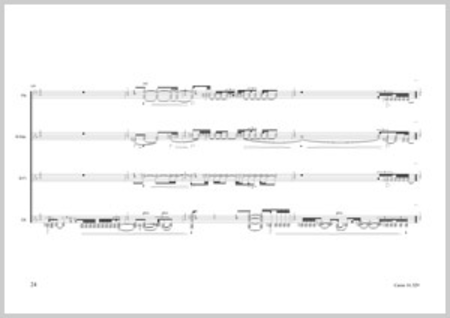Une Geometrie, Nr. 2 - Incantation
for guitar solo, flute, baritonsaxophone and viola
-
Ships in 2 to 3 weeks
Details
Description
SKU: CA.1632900
For guitar solo, flute, baritonsaxophone and viola. Composed by Walter Feldmann. This edition: Paperbound. German title: Incantation 2007. Full score. Composed 2007. 38 pages. Carus Verlag #CV 16.329/00. Published by Carus Verlag (CA.1632900).ISBN 9790007113506. Language: all languages.
The texts of the French author Anne-Marie Albiach have long been the point of departure for my works. Following the viola concerto << monstrueuse vecut dans le cadre >> la memoire, which is based on her << H II >> lineaires, the three texts entitled << une geometrie >> have generated a new cycle. As in the other two works of the cycle, << incantation >> is predicated upon two different readings of the text: on the one hand a (private) reading by Anne-Marie Albiach in which time is measured out; while on the other hand the graphic text is measured millimeter by millimeter. The latter serves as the basis - the "genetic code" - for the temporal, horizontal structures of the solo part, whereas the reading of the author appears in the rhythmic surfaces of the accompanying trio, which intersect the horizontal plane. In << incantation >> one clearly recognizable element is repeated: a tritone chord of E-e-b flat-e', which - transposed a half tone lower - was of fundamental importance in my guitar duo << how many parts of it - the one, - and [how many] [the] other >> nr. 2 << the other >>. For the generation of tone materials this chord is compressed and stretched within the ranges (frames) of tones which are derived from the horizontal positions of the text fragments: lower, borderline tones on the left margin, higher borderline tones on the right margin. Thus the disposition on the page, essential for Anne-Marie Albiach (and first introduced in poetry by Mallarme in "Un coup de des jamais n'abolira le hasard"), is rendered in sound. Naturally each element of the text serves to mould structure and dynamics, including the typography: fragments within quotation marks, in italics, etc., yield different sonorities and movements. Whereas the solo guitar articulates rhythmically each character of the text, the rhythms of the trio articulate only its syllables and words. Each word of the author's reading of the text is instrumentated differently, which is important for the entire cycle. Thus a compact network of instrumental combinations is created in which, word for word, the text is made audible.

 Share
Share